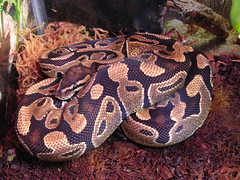
Should you be in the position of purchasing a new pet, and have decided that you want to venture into the world of ball pythons, you will need to do some research. It is always a good idea to know everything you can, about an exotic animal that you intend on keeping as a pet. There are many simple guidelines that should be followed when it comes to the care of a ball python, some can be considered experience and some can be considered common sense. The object of the common practices that you follow while raising ball pythons is to keep the snake from getting stressed out and not becoming socialized or tamed. Should you find yourself in a position of owning an untamed and anti-social ball python, it is something that you will not soon forget.
Housing
When it comes to a home for your new ball python, you will want to be sure that it will be safe as well as secure so that the snake will not get out on its own. Snakes are the masters of escape, and the ball python is no exception to this. The enclosure should be big enough for the snake to stretch out if it so desired, yet not too big where it takes up an entire room. While ball pythons in captivity rarely reach the full potential of their size, being approximately 6 feet they will still get within a 4-foot to 5-foot length. Many people find a 50-55 gallon tank appropriate for the housing of a ball python. You will need a ventilated lid where the snake cannot squeeze out of the holes, yet the lid needs to be very secure as many snakes will push the lid open with their snouts.
Temperatures
Ideally the best temperatures for your snake in the daytime would fall in at around 80-85 degrees F, this can be accomplished a few different ways. You can get heating pads and place them under a section of the tank, when we say section this could equate to approximately 30-40% of the tanks length. You can place a heat lamp over the tank in a certain area to give maximum basking temps up to around 95 degrees F, yet there needs to be a cooler section should your snake find it too stuffy in their enclosure. In the evening the tank can indeed drop in temps to around 80 degrees F, and the snake will be very comfortable.
Tank Mates
While ball pythons can in fact be rather tame and docile, it really is not recommended for you to place more than one snake in any one enclosure at any one time. This rule of thumb can be moot of course when it comes to breeding, yet it should still be followed on a regular basis. Snakes really do not need or desire tank mates as they are pretty much solitary beings, and do not share the social lifestyle of other pets such as hamsters or cats and dogs.
Feeding
When it comes to feeding your ball python, there are but a few common rules to follow. When the snake is a juvenile you will want to feed the snake weekly on a diet of rodents that are no bigger than the girth of the middle of the snake. When the snake matures this feeding regime can slow to every 10-14 days. The common rule of the size of the meal would still apply however, no bigger than the girth of the middle of the snake’s body. If you are feeding frozen dead prey, make sure that you have thawed the prey out to body temp prior to feeding the snake as snakes really do not have all that great of a digestive tract and it will only take longer for the snake to finish the meal. Live prey today is actually scorned by enthusiasts, as it is cruel and inhumane to subject fear into the prey. It is also possible for the prey to attack the snake out of fear, which can indeed cause much harm to the snake.
Medical Issues
While a ball python is not like a cat or dog, there are vets in your area that can actually tend to snakes as pets. While you may find it a little more difficult to obtain a vet, to tend to your snake never rule out the possibility of finding one to treat your sick or injured ball python.
No comments:
Post a Comment